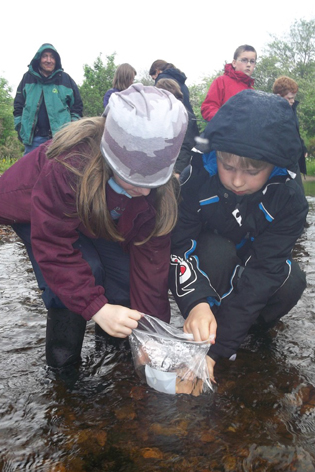 The Sunart Community Company and Strontian Angling Association have embarked on an ambitious, long-term plan to save the Strontian River’s salmon. No salmon have been caught on the Strontian for many years and the number of juvenile fish in the river suggested that only a handful were spawning each year and that the population was close to extinction. In June more than 10,000 young hatchery-reared salmon were released into the river in an attempt to restore this iconic species.
The Sunart Community Company and Strontian Angling Association have embarked on an ambitious, long-term plan to save the Strontian River’s salmon. No salmon have been caught on the Strontian for many years and the number of juvenile fish in the river suggested that only a handful were spawning each year and that the population was close to extinction. In June more than 10,000 young hatchery-reared salmon were released into the river in an attempt to restore this iconic species.
Dr Diane Baum, Biologist for the Lochaber Fisheries Trust, said: “The stocking of hatchery-reared salmon into rivers is not new, but the desire to preserve the unique, indigenous Strontian line meant that innovative ways had to be found to source eggs from the extremely small number of salmon in the river. Working with the Lochaber Fisheries Trust, the Angling Association collected thirty young salmon parr from the Strontian. These fish were no more six inches long at capture and had never left the river and migrated to sea. With funding from the Nineveh Charitable Trust and the Sunart Community Council the salmon were reared on in tanks by Pete Madden and other members of the local Angling Association and then at a commercial hatchery. After two years of dedicated care they were full-grown adults ready to produce the next generation of Strontian salmon.”
Dr Baum added: “In an ideal world, salmon would prosper without our intervention, but the population on the Strontian was so precarious that extinction was a real possibility. We have done everything possible to ensure that the fry stocked into the river are as fit and healthy as possible, and great credit must go to Pete Madden and the Strontian Angling Association for their vision and hard work to reach this point. It is exciting to think that good numbers of salmon could once again run the Strontian River.”
Give the determination to restore native salmon, it was important to make sure that the fish in the hatchery really were actually from wild Strontian stock. Escaped farmed fish had been caught on the Strontian in the past raising concerns that young salmon in the river may be their descendents. To ensure only wild fish were bred from, all fish taken into the hatchery were individually tagged and genetically screened by genetic scientists working for the Rivers and Fisheries Trusts of Scotland. No farmed fish were found, but, as is often the case in very small populations, many of the salmon were closely related. The genetic information allowed a breeding plan to be drawn up that reduced inbreeding and maximised diversity in the next generation.
The first young salmon produced by the initiative are now exploring their new home in the Strontian River. Pupils from the local primary school helped with the releasing of salmon fry into suitable areas along the river and will be following their progress closely. The hope is that in a few years time these fish will return as adults to spawn and recreate a thriving salmon population on the Strontian.
Pete Madden, Secretary of the Strontian Angling Association, recalled: “I can remember that as a teenager in the 1960’s during summer evenings we used to meet on the Strontian Bridge and watch the salmon come up the river mouth on the high tide. Also when standing on the bridge at the Church Pool, when water levels were low, we could always see a half dozen or so salmon in the pool below. If someone then had said that the salmon would be virtually gone from the river in another forty years, we would not have believed them. Just maybe, we will see them splashing in the pools again?”
